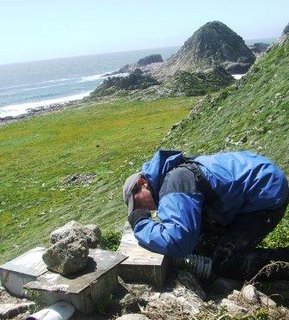 The seabird breeding season has officially begun with the first eggs laid by Cassin’s Auklets on April 11th. This is the true start of the seabird research season. We will now begin monitoring the success of seabirds by determining the number of birds that breed, the number of eggs that are laid, the number that hatch, and the number of chicks which fledge. Cassin’s Auklets are one of the many species that breed on the island and we have studied their populations and reproductive success here since 1972. They are small seabirds (about the size of a robin) that spend most of their lives at sea, feed on zooplankton and nest underground in burrows, rocky crevices, or in nest boxes.
The seabird breeding season has officially begun with the first eggs laid by Cassin’s Auklets on April 11th. This is the true start of the seabird research season. We will now begin monitoring the success of seabirds by determining the number of birds that breed, the number of eggs that are laid, the number that hatch, and the number of chicks which fledge. Cassin’s Auklets are one of the many species that breed on the island and we have studied their populations and reproductive success here since 1972. They are small seabirds (about the size of a robin) that spend most of their lives at sea, feed on zooplankton and nest underground in burrows, rocky crevices, or in nest boxes.Biologists from PRBO check nest boxes every five days beginning on March 2nd each year. We monitor these boxes throughout the season looking for birds with their eggs and eventually chicks.
 When we find a bird in a box, we capture the adults, determine their band number or place a band on them, and take a variety of measurements (wing length, weight, bill size) which help us to determine the sex of the bird and give us an index of their overall health. Banding birds allows us to keep track of individuals through time and to examine survival, fidelity to nest locations and mates, and the overall reproductive success of individual birds throughout their lives. These boxes create additional nesting habitat and allow us to collect valuable breeding information with a minimum of disturbance to the birds.
When we find a bird in a box, we capture the adults, determine their band number or place a band on them, and take a variety of measurements (wing length, weight, bill size) which help us to determine the sex of the bird and give us an index of their overall health. Banding birds allows us to keep track of individuals through time and to examine survival, fidelity to nest locations and mates, and the overall reproductive success of individual birds throughout their lives. These boxes create additional nesting habitat and allow us to collect valuable breeding information with a minimum of disturbance to the birds.Cassin’s Auklets are usually the first birds to breed on the island and the timing of their reproduction can often indicate if it will be a productive year for seabirds at the Farallones. Auklets tend to initiate breeding earlier when the ocean is cold and conditions are favorable for the production of their favorite food, krill.
 In warmer years, there is less food available and they will delay breeding until conditions improve. So, this species serves as an "early warning" system for overall seabird productivity. For example, last year the ocean was warm, food was scarce and the first eggs were not observed until May 1st, a full three weeks later than this year. As a result the auklets (and other seabirds at the Farallones) were able to rear few chicks. Hopefully, the earlier breeding observed this season is a sign of more favorable conditions and higher productivity for auklets.
In warmer years, there is less food available and they will delay breeding until conditions improve. So, this species serves as an "early warning" system for overall seabird productivity. For example, last year the ocean was warm, food was scarce and the first eggs were not observed until May 1st, a full three weeks later than this year. As a result the auklets (and other seabirds at the Farallones) were able to rear few chicks. Hopefully, the earlier breeding observed this season is a sign of more favorable conditions and higher productivity for auklets.While Cassin's Auklets are the first to lay their eggs, the other seabird species are getting ready. Western Gulls, Brandt's, Pelagic and Double-crested Cormorants are all establishing their territories and building nests. Common Murres have been at their breeding sites every day and have been practicing by incubating rocks or small bits of vegetation. Puffins have returned to the colony and the Rhinoceros Auklets and Ashy Storm-petrels have been in at night. Soon these species will have eggs too and things will get very busy for the next few months.
No comments:
Post a Comment